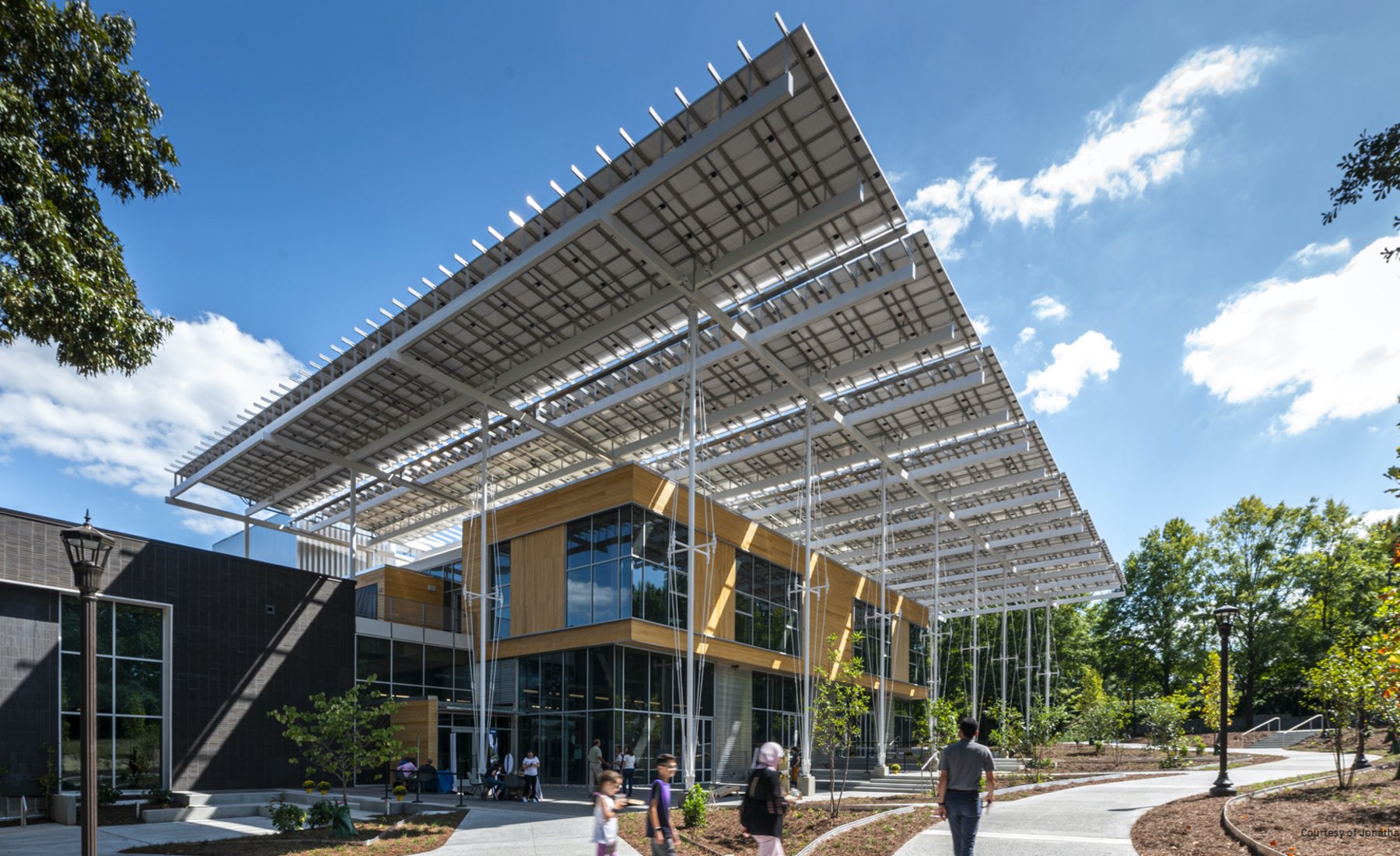Reimagining a Net-Positive Future
On Aug. 9, 2020, the temperature sizzled at 96 degrees in Atlanta. It was the hottest day of the year, and air conditioners churned at full power across the Deep South. But inside the Kendeda Building for Innovative Sustainable Design on the Georgia Tech campus, the air remained cool and humidity stayed at comfortable levels despite the lack of a conventional cooling system.
With 37,000 square feet of education and research space, the Kendeda Building is much more than energy-efficient, complying with all 20 imperatives of the Living Building Challenge. From its water reclamation system and use of salvaged materials to its rooftop vegetable garden and solar panels that generate twice the amount of power than it needs annually, the building is net-positive, contributing more positive impacts to the environment than harmful emissions and consumption.

Built by Skanska USA using software from Autodesk, the Kendeda Building represents progress in how buildings address their massive carbon footprint, which accounts for 38 percent of energy-related CO2 emissions annually. A 2020 Autodesk survey of architecture, engineering and construction professionals showed that about half of their companies have budgets dedicated to carbon management, with about 90 percent likely to make such investments in the future.
The growing resolve to overcome the environmental impact of design-and-make industries like architecture, engineering, construction, product design and manufacturing arrives just as the technology has advanced to meet the challenge. Autodesk, for example produces software that helps speed complex design processes and transform data into actionable insights—such as finding the hidden climate impacts of building material choices—that help innovators reduce the impact of everything they design, make, own and operate.
For decades, buildings have been designed as if resources were unlimited. By using digital tools and low-carbon development practices, companies can prioritize sustainable material choices, reducing operational and embodied carbon in buildings as well as waste before a project even breaks ground.
“Waste and pollution are not accidents but the consequences of decisions made at the design phase, where around 80 percent of our environmental impacts are determined,” says Ellen MacArthur founder of the Ellen MacArthur Foundation, a think tank that promotes the idea of a “circular economy” in which industries, government and academia collaborate on growth and environmental stewardship.
Technology-aided, cost-effective sustainable design is increasingly serving communities around the world. For the Kendeda Building, the project team used 3D modeling, cloud collaboration and virtual reality tools to model, iterate and price thousands of evolving designs accurately and quickly. The team was able to compare sustainable materials and costs, then toggle through options to see differences. For example, a virtual reality demonstration revealed that 45 percent glazing of the facade would allow sufficient natural light and remain within budget, a design choice with huge financial and environmental impact.
“Often one change would have a cascading effect on all the imperatives we needed to meet,” says Skansa USA director of project solutions Jimmy Mitchell. “We couldn’t have met this goal for a regenerative building without the technology we have today.”
Infrastructure is another industry ripe for sustainable design solutions. The World Bank estimates that nearly 9 trillion gallons of water are wasted each year worldwide due to leaks and pipe breaks. Most of the U.S. water infrastructure was built in the early 1900s and is in acute need of renovation.
The city of Toledo, Ohio, offers an example of how to improve municipal water infrastructure with today’s advanced tools. In 2014, a toxic algal bloom contaminated drinking water and led to state-mandated deadlines to modernize the city’s water system. The conventional infrastructure design process, in which consultants and planners in various disciplines typically upload and download massive design files, is slow and error-prone, and was too inefficient to meet the expedited timelines.

The project team, led by Arcadis, used Autodesk’s software to link consultants across the country in real time, saving more than 1,000 design hours. By spring of 2020, just as Covid-19 emerged, two new water basins became operational in Toledo. As finishing work stretched through the fall, Arcadis used augmented reality tools to visit the job site virtually and maintain safety protocols.
“We saw value in these collaboration tools throughout the life cycle of the project,” says Kurt Smith, project manager for Arcadis. “Most importantly, they delivered a better result for our customers. The winners here are the residents of Toledo, who now have a water treatment facility they can count on.”
The product design and manufacturing industries rival construction in environmental impact, producing 19 percent of global greenhouse gas emissions globally. That makes the choices of manufacturers critical in addressing climate change. For example, Salt Lake City-based ski equipment manufacturer WNDR Alpine is producing a new ski made partly from a novel—and plentiful—material. The company uses Autodesk software in the process of engineering the skis, which are made of sustainable, high‑performance material derived from microalgae instead of petroleum. By replacing petroleum, which is used in traditional skis, with a sustainable material, WNDR Alpine is significantly reducing the amount of waste generated during production by about two pounds of landfill input per manufactured ski.

“Without Autodesk, we would not be able to realize these waste savings,” says Matt Sterbenz, WNDR Alpine’s founder. “We’re able to bring the ski to life on the screen and identify areas where we can streamline the production process, so that we’re only using as much of our urethane as we’re actually going to need in the final good.”
While Autodesk’s powerful technology unlocks new solutions for innovators—from informed design and specification to improved processes and operational efficiencies, and enhanced product performance—the company has long led by example in its own business operations to accelerate sustainable outcomes. A decade ago, Autodesk set ambitious greenhouse gas emission reduction targets. Now, it is net-zero GHG across its entire business.
To reach net zero, the company created the Autodesk Carbon Fund, which it uses to investment in renewable energy and certified carbon offsets. This year, Autodesk joined the Science Based Target Initiative’s 1.5 C Business Ambition Pledge to reduce emissions even further.
“Our efforts on operational climate goals have given us the knowledge to be a better partner to our customers. Using what we’ve learned, we’re enabling innovators to design and build products, buildings and entire cities that are healthier, more resilient and better connected,” says Autodesk vice president of sustainability Lynelle Cameron. “These benefits have clear economic value for our customers while making a better, more sustainable and equitable world for all.”
